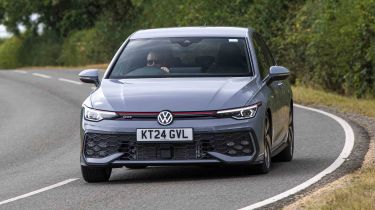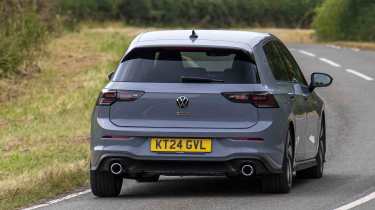Volkswagen Golf GTI - Engines, performance and drive
The eighth-generation Golf GTI is still great to drive; with strong power reserves and an array of engineering trickery

One of the Volkswagen Golf GTI’s key traits has always been its ability to offer a balanced set-up; not too hardcore to drive on a daily basis, but not too soft that it becomes dull and uninspiring out on the road.
The standard GTI has seen a power boost as part of the facelift, although that change can only really be felt if you extend the engine towards the red line, where there’s a little more eagerness than before. The rest of the time, it’s much the same; in other words, there’s plenty of flexibility low-down thanks to an unchanged peak torque of 370Nm. The engine doesn’t make the most exciting noise (the same can be said of most four-cylinder turbocharged hot hatches), so it’s down to some slightly love-or-hate exhaust crackles to add a bit of intrigue.
|
Model |
Power |
0-62mph |
Top speed |
|
Golf GTI DSG |
261 bhp |
5.9seconds |
155mph |
|
Golf GTI Clubsport DSG |
296bhp |
5.6seconds |
155mph |
What is the Volkswagen Golf GTI like to drive?
In town
The Golf GTI is easy to drive during the boring daily grind, and really nails the everyday usability qualities. The brakes are easy to modulate at low speeds, and the steering is light enough when parking to make slotting it into a difficult space easier than it would be in a Honda Civic Type R.
Even with its standard suspension set-up, the Golf GTI has a more composed ride than the closest competition, though to get the best out of the GTI, we’d recommend spending an extra £720 for Adaptive Chassis Control. This introduces the electrically controlled dampers and the scope to adjust them through 15 response levels. This widens the Golf’s scope even further, giving a firm track-only setup at its most extreme, to a cossetting cruiser capable of dealing with potholes and speed bumps at its softest – all while still maintaining great body control.
On A- and B-roads
Hot hatches are more about the corners than what they’re like in town, and here the Golf GTI remains as sophisticated as before. Grip is superb on the front axle, which gives the driver huge confidence to lean heavily on the driven tyres into a corner. Yet with that agility comes a great deal of security, too.
Used - available now

2024 Toyota
Aygo X
31,613 milesManualPetrol1.0L
Cash £10,909
2021 Toyota
Yaris Cross
15,123 milesAutomaticPetrol1.5L
Cash £23,601
2024 VOLKSWAGEN
CRAFTER
48,000 milesManualDiesel2.0L
Cash £19,990
2023 Tesla
Model 3
55,300 milesAutomaticElectric
Cash £17,495Even with a little trail braking towards an apex, the back end doesn’t feel obliged to lose its resolve – at least away from the higher speeds of a race track – and mid corner throttle lifts cause the nose to gently tuck in rather than upset the balance too much. Some will prefer the slightly more playful feel you get from a Ford Focus ST or a Honda Civic Type-R, but there’s plenty of fun for experienced drivers while remaining accessible to more general buyers.
Those Ford and Honda drivers will feel a little more connected to the action, too, because they have access to a six-speed manual gearbox instead of the auto-only Golf. While it’s a sharp and responsive dual-clutch system, it can’t match the feeling of interaction that you get from three pedals and a gear lever.
On the motorway
As you’d expect for such a versatile hot hatch, the Golf GTI is an excellent motorway cruiser. Long distances can be covered without the smallest hint of stress, and aside from a little more road noise from those low profile tyres, the GTI is no less refined than a base model Golf.
0-62mph acceleration and top speed
Both the regular Volkswagen Golf GTI and the GTI Clubsport use the same ‘EA888’ 2.0-litre turbocharged engine. The regular GTI has gained an uplift in power from 242bhp to 261bhp, which means that the 0-62mph time dips below the six second mark; the 5.9-second time undercuts the old car by 0.4 seconds. The GTI Clubsport continues above the standard car, and with 296bhp and 400Nm, it’s also a lot more potent, with the 0-62mph sprint taking 5.6 seconds.
If you happen to find yourself on a derestricted autobahn, then the GTI and GTI Clubsport can be maxed out at a limited top speed of 155mph.











